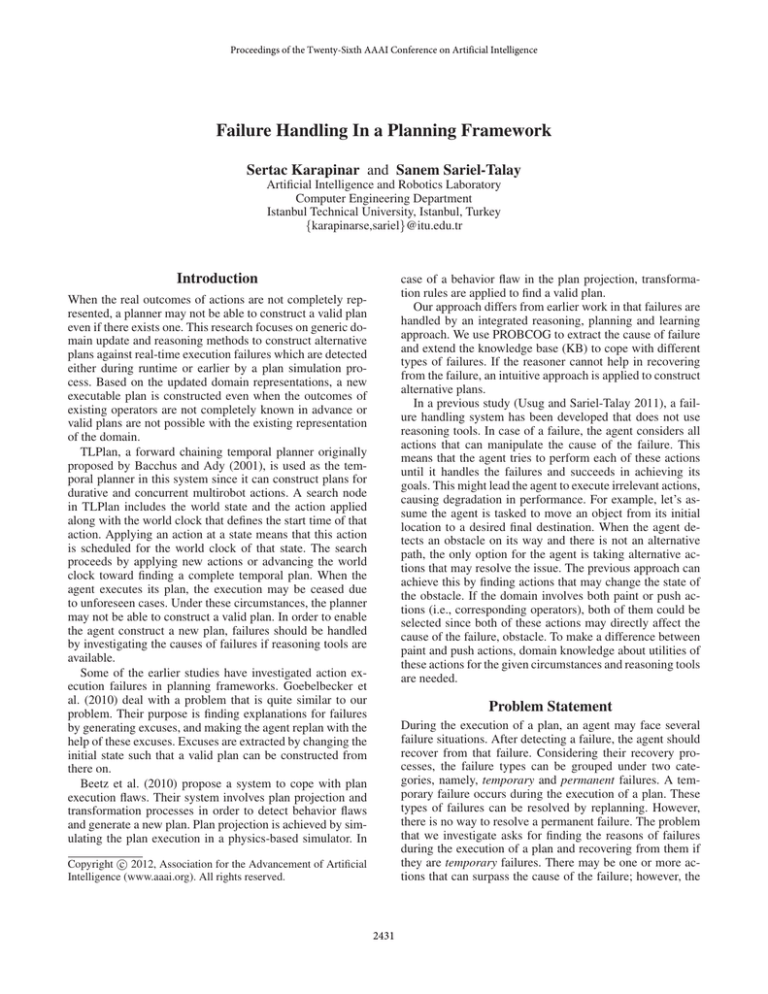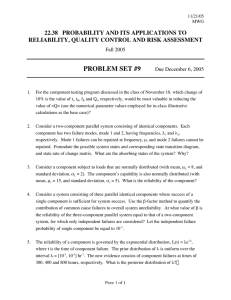
Proceedings of the Twenty-Sixth AAAI Conference on Artificial Intelligence
Failure Handling In a Planning Framework
Sertac Karapinar and Sanem Sariel-Talay
Artificial Intelligence and Robotics Laboratory
Computer Engineering Department
Istanbul Technical University, Istanbul, Turkey
{karapinarse,sariel}@itu.edu.tr
Introduction
case of a behavior flaw in the plan projection, transformation rules are applied to find a valid plan.
Our approach differs from earlier work in that failures are
handled by an integrated reasoning, planning and learning
approach. We use PROBCOG to extract the cause of failure
and extend the knowledge base (KB) to cope with different
types of failures. If the reasoner cannot help in recovering
from the failure, an intuitive approach is applied to construct
alternative plans.
In a previous study (Usug and Sariel-Talay 2011), a failure handling system has been developed that does not use
reasoning tools. In case of a failure, the agent considers all
actions that can manipulate the cause of the failure. This
means that the agent tries to perform each of these actions
until it handles the failures and succeeds in achieving its
goals. This might lead the agent to execute irrelevant actions,
causing degradation in performance. For example, let’s assume the agent is tasked to move an object from its initial
location to a desired final destination. When the agent detects an obstacle on its way and there is not an alternative
path, the only option for the agent is taking alternative actions that may resolve the issue. The previous approach can
achieve this by finding actions that may change the state of
the obstacle. If the domain involves both paint or push actions (i.e., corresponding operators), both of them could be
selected since both of these actions may directly affect the
cause of the failure, obstacle. To make a difference between
paint and push actions, domain knowledge about utilities of
these actions for the given circumstances and reasoning tools
are needed.
When the real outcomes of actions are not completely represented, a planner may not be able to construct a valid plan
even if there exists one. This research focuses on generic domain update and reasoning methods to construct alternative
plans against real-time execution failures which are detected
either during runtime or earlier by a plan simulation process. Based on the updated domain representations, a new
executable plan is constructed even when the outcomes of
existing operators are not completely known in advance or
valid plans are not possible with the existing representation
of the domain.
TLPlan, a forward chaining temporal planner originally
proposed by Bacchus and Ady (2001), is used as the temporal planner in this system since it can construct plans for
durative and concurrent multirobot actions. A search node
in TLPlan includes the world state and the action applied
along with the world clock that defines the start time of that
action. Applying an action at a state means that this action
is scheduled for the world clock of that state. The search
proceeds by applying new actions or advancing the world
clock toward finding a complete temporal plan. When the
agent executes its plan, the execution may be ceased due
to unforeseen cases. Under these circumstances, the planner
may not be able to construct a valid plan. In order to enable
the agent construct a new plan, failures should be handled
by investigating the causes of failures if reasoning tools are
available.
Some of the earlier studies have investigated action execution failures in planning frameworks. Goebelbecker et
al. (2010) deal with a problem that is quite similar to our
problem. Their purpose is finding explanations for failures
by generating excuses, and making the agent replan with the
help of these excuses. Excuses are extracted by changing the
initial state such that a valid plan can be constructed from
there on.
Beetz et al. (2010) propose a system to cope with plan
execution flaws. Their system involves plan projection and
transformation processes in order to detect behavior flaws
and generate a new plan. Plan projection is achieved by simulating the plan execution in a physics-based simulator. In
Problem Statement
During the execution of a plan, an agent may face several
failure situations. After detecting a failure, the agent should
recover from that failure. Considering their recovery processes, the failure types can be grouped under two categories, namely, temporary and permanent failures. A temporary failure occurs during the execution of a plan. These
types of failures can be resolved by replanning. However,
there is no way to resolve a permanent failure. The problem
that we investigate asks for finding the reasons of failures
during the execution of a plan and recovering from them if
they are temporary failures. There may be one or more actions that can surpass the cause of the failure; however, the
c 2012, Association for the Advancement of Artificial
Copyright Intelligence (www.aaai.org). All rights reserved.
2431
parameters of pick up action are updated so that the robot
changes its orientation w.r.t the object and tries to pick up the
object again. If it fails in its second attempt, the orientation
is updated again. At the end of the third attempt, the KB
includes the following facts:
agent may not be aware of them. When the effects of these
types of actions do not directly contribute to the ultimate
goal of the agent, the planner may fail to add these actions to
the constructed plan. A solution to this problem should successfully add those actions into the plan so that failures are
resolved. It is obvious that a reasoning mechanism is needed
to realize the necessity of these types of actions to achieve
the goal. Therefore, integrating a reasoner is a crucial part of
our work to ensure a more systematic way to handle failures.
Red(x)ΛCube(x)ΛOrientation(α, x)ΛP ickU pF ailed(x)
Red(x)ΛCube(x)ΛOrientation(β, x)ΛP ickU pF ailed(x)
Red(x)ΛCube(x)ΛOrientation(γ, x)ΛP ickU pF ailed(x)
A Case Study
If the above facts are the only knowledge in the robot’s
KB, a permanent failure assumption is made and the
following hypothesis is constructed:
As a motivating example to illustrate the above mentioned
problem, a scenario can be given with a robot and several objects to be moved from their starting positions to the given
goal positions. The robot is able to execute several actions
such as pick up, put down objects by its gripper and move
from one location to another. However, the robot might drop
an object while trying to pick it up. This failure might occur
because of several reasons such as the weight of the object
or wrong grasp position. The robot can handle the failure
by executing pick up action with different parameters if the
reason of the failure is its wrong grasp position. If the robot
fails in achieving picking up the object because of its weight,
there is no way to pick it up. Replanning may lead the robot
keep dropping the object repeatedly. Other the other hand,
another action (e.g., push) which does not directly contribute
to the robot’s goal can handle this type of failure. To resolve
the failure, this action should be added into the plan. A reasoning mechanism can figure out the cause of the failure in
such cases and updates the KB so that the necessary actions
are included in the plan.
[Red(x) Λ Cube(x)] ⇒ P ickU pF ailed(x)
After trying to pick up some other red cubical objects and
making new observations, the hypothesis might be strengthened or rejected.
Conclusion
In this paper, we propose combining a planner with a reasoner to help an agent handling failures during its plan execution. This is achieved even when the planner cannot come
up with a valid plan considering the domain operators due to
lack of exact information on the actual outcomes of actions
that may resolve the failure. We show that if a reasoning tool
is not available to the agent, the problem could be resolved
at the expense of irrelevant actions. The intuitive idea that
is applied in this case is finding actions that may change the
state of the failure. If a reasoner, PROBCOG in our case, is
provided, then more efficient solutions can be attained. Our
ongoing work includes a method to find actions that have direct relations to the cause of failure. By using this approach,
irrelevant actions are not selected anymore.
Reasoning on Failures
We combine the TLPlan planner with a first-order probabilistic reasoner PROBCOG to solve the issue mentioned
above. TLPlan is used to construct a temporal plan. If the
plan fails during its execution, PROBCOG uses the KB
and the incoming information from the agent’s sensors, and
makes new conclusions about the cause of the failure. Two
types of conclusions can be made: (1) the parameters of a
failed action are updated to handle failures, (2) a permanent
failure is detected when the robot gives up executing an action that fails after several trials. The KB is also extended to
include these new conclusions that enables replanning. The
updated planning problem is fed into the planner to re-plan
for the given situation.
The reasoning tool enhances the planning process in three
ways:
References
Bacchus, F., and Winter, M. A. 2001. Planning with resources and concurrency a forward chaining approach.
Beetz, M.; Jain, D.; Msenlechner, L.; and Tenorth, M.
2010. Towards performing everyday manipulation activities.
Robotics and Autonomous Systems 58(9):1085 – 1095.
Gobelbecker, M.; Keller, T.; Eyerich, P.; Brenner, M.; and
Nebel, B. 2010. Coming up with good excuses: What to do
when no plan can be found.
ProbCog.
2012.
Probcog tool box.
http:
//wwwbeetz.informatik.tu-muenchen.de/probcogwiki/index.php/Main˙Page.
Usug, U., and Sariel-Talay, S. 2011. Dynamic temporal
planning for multirobot systems.
• New conclusions can be made about the world when the
agent is failed to execute an action.
• New conclusions can be made to find an executable action
that might resolve the failure.
• Further conclusions about the utility of future behaviors
can be made considering specific properties of objects.
The following example from our example scenario shows
how our reasoning module works. The robot tries to pick
up a red cubical object. When it fails in its first attempt, the
2432




